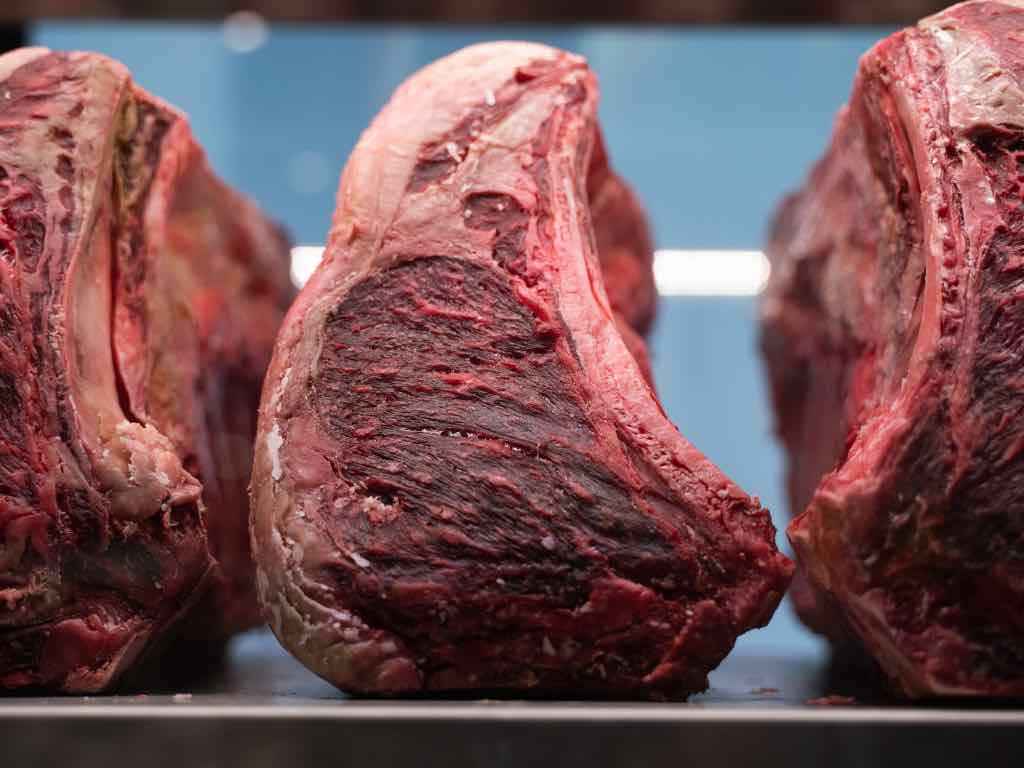
What Is Dry Aged Steak? A Deep Dive into Flavor & Cooking
|
|
Time to read 4 min
Welcome to One Stop Halal!
Written by: Samir P.
|
|
Time to read 4 min
Dry-aged steak is a culinary delicacy renowned for its intense beefy flavor and incredibly tender texture. It’s a process that transforms an ordinary cut of beef into a premium dining experience, coveted by steakhouses and gourmet chefs alike. But what is dry aged steak, and how does it enhance the quality of the meat? In this blog, we’ll dive deep into the science, technique, and taste of dry-aged steak.
Dry aging a steak is a controlled process in which beef is stored in a specific environment for an extended period, typically 21 to 60 days, though some premium cuts can be aged for even longer. During this time, the beef is kept at a precise temperature (34–38°F or 1–3°C) and humidity level (around 80%), with proper air circulation to prevent spoilage.
Unlike wet aging in vacuum-sealed packaging with minimal flavor development, dry aging allows for more profound taste evolution and textural enhancement.
During the aging process, several biological changes take place within the meat:
The duration of dry aging significantly impacts the final taste and texture:
While aging for more extended periods enhances complexity, it's a matter of personal preference. Some enjoy the deep funkiness of a 60-day-aged steak, while others prefer the balanced flavor of a 30-day aging process.
Not all beef cuts are suitable for dry aging. The best cuts have a high level of marbling and a thick fat cap to protect the meat during the process. The most commonly dry-aged cuts include:
One of the most popular choices for dry aging, ribeye has an excellent fat-to-meat ratio, making it incredibly flavorful and tender. The marbling in ribeye enhances its buttery texture and rich umami notes after aging.
A slightly leaner cut compared to ribeye, the New York strip still possesses excellent marbling and benefits significantly from the aging process. It develops an intensified beefy flavor while maintaining a firm texture.
These cuts contain a combination of strip steak and tenderloin, making them a prime choice for dry aging. The tenderloin side remains delicate, while the strip side develops a rich, aged complexity.
Although leaner than ribeye or New York strip, sirloin still ages well, particularly with good marbling. Aged sirloin boasts deep umami flavors with a slightly firmer texture.
Any cut with the bone left in, such as a tomahawk steak or bone-in ribeye, benefits from dry aging. The bone helps retain moisture and enhances the final flavor.
Choosing the right cut for dry aging is essential for maximizing the texture and taste of your steak. While ribeye and New York strip are the most favored, adventurous eaters may enjoy experimenting with different cuts to find their ideal aged steak.
Dry-aged steak is often found in high-end steakhouses, specialty butcher shops, and gourmet grocery stores. Some online retailers also ship dry-aged beef directly to consumers.
If you’re up for a challenge, you can even dry-age steak at home using specialized fridges or chambers. However, careful attention to temperature, humidity, and air circulation must be paid to ensure safety and proper aging.
Cooking dry aged steak requires a slightly different approach due to its reduced moisture content. Follow these steps for the best results:
However, traditional cuts may be more suitable for your palate if you prefer a milder, juicier steak.
Welcome to your favorite Butcher Shop. We carry various meat cuts that are hard to find elsewhere. We deliver to your doorstep anywhere in the United States within 1-2 business days.
Dry-aged steak is a testament to the art and science of beef aging. Whether enjoying it at a high-end steakhouse or experimenting with aging at home, understanding the process enhances your appreciation of this culinary marvel. If you’ve never tried what is a dry aged steak, it’s time to treat yourself to one of the most flavorful and satisfying cuts of beef available.

© 2025 One Stop Halal, Inc.